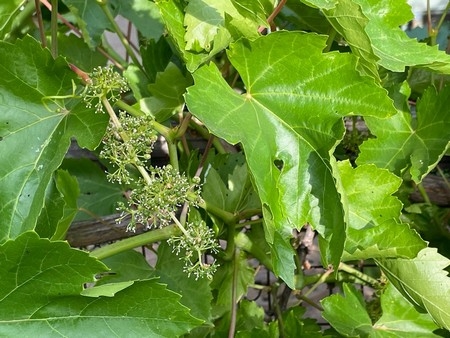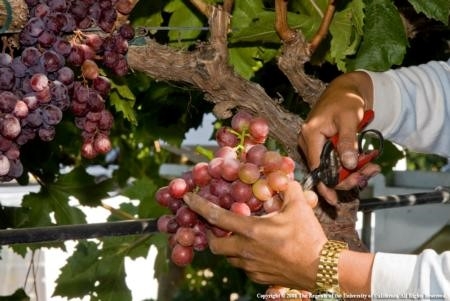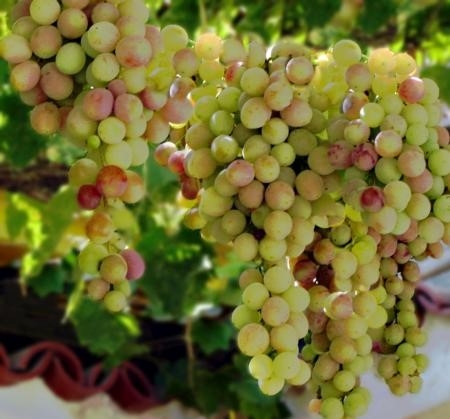According to someone who knows such things, grapes are one of the most widely cultivated fruit crops in the world. Worldwide, there are over 10,000 different varieties, and whether one's interest is ambience, erosion control, raisins, jelly, table munchies, or wine, grapes nicely fit the bill. While grapevines are relatively hardy, they still need year-round care to be most productive.
There are extensive data regarding the growth and maintenance of grapes. Specific recommendations for when/where/how and why will depend upon some critical factors like soil type, location, sun exposure, grape variety, and more.
There are a few generalities that are helpful to home gardeners wanting grapes to be an integral part of their garden landscape.
- First, grapes need sun, full sun if possible, because less light results in lower fruit production, poorer fruit quality, and an increased incidence of certain diseases like powdery mildew.
- Second, grapevines can thrive in a variety of soil types, but good drainage is critical. Grape roots can be very extensive and deep, so ideally there should be 3–4 feet of soil above hardpan or rock layers. Table grapes tend to grow quite well on less fertile soils. On poorly drained soil, a large amount of well-decomposed compost should be incorporated before planting.
- Third, grapes need space, the amount of which is dependent upon the desired use of the fruit. Spacing between rows of wine grapes can be as little as 8 feet up to as much as 12 feet in very deep rich soils. Home grapes are often grown on arbors and in that situation one vine would require 50–100 square feet of arbor space. If the interest is only a few grapevines, then a space of at least 3 feet between plants would be a minimal requirement.
- Fourth, water requirements vary as a function of soil type and plant maturity. Water leaches quickly from sandy soils while it tends to collect in heavy clay. New vines should be watered weekly, sufficient to wet the soil 6–10 inches deep. Some recommendations suggest ½–1 inch of water/week for new vines. Five gallons of water spread over a 3' x 3' area is equal to about 1 inch of water. Established vines (over 2 years) can be relatively drought tolerant, but regular watering down to 12 inches will improve productivity. Once vines set fruit, watering can be reduced. Given that water use is so dependent upon a variety of factors like soil type, slope, sun exposure, it is difficult to prescribe a specific water regimen that is applicable to all.
Grapes can be grown from bare root preparations, usually with a fruiting cane grafted onto a disease resistant rootstock; this is probably the safest way to proceed. Alternatively, most grapes can be propagated as ‘own rooted' where a mature cane is simply placed in potting soil. This can be very successful, but the resultant vines are not disease resistant.
Canopy management is extremely important not only for optimization of fruit quality but also for management of potential problems, like powdery mildew. Shoot thinning is done primarily to reduce shoot congestion in the fruiting zone and to adjust flower cluster numbers. In addition to reducing the number of shoots emerging from the crown of the vine, the canes or the spurs, it is also important to strip leaves to increase light and reduce humidity in the fruit zone. However, in areas that can be very hot, it is important that there is adequate leaf coverage over the fruit to reduce sunburn or fruit shrinkage.
Proper pruning is critical to maintain good plant structure, optimize productivity and allow adequate vegetative growth for the following season. Unpruned vines will have excessive numbers of grape clusters and the vine will be unable to ripen the large crop. Pruning is done when the vines are dormant and just before bud break. Mid to late February is a good time in most of Contra Costa County. There are many approaches to pruning which depend, primarily, upon how the grapes are grown. This website has more information about pruning: https://ipm.ucanr.edu/PMG/GARDEN/FRUIT/CULTURAL/grtrainprune.html
Like any plant, there are various types of diseases or conditions that can seriously impact grapevines. Some of the most notorious, such as phylloxera (an aphid-like insect that can destroy roots) or nematodes, can be managed by using disease-resistant rootstock stock. There are many other potentially serious conditions but in the home garden the most likely condition the homeowner will encounter is powdery mildew. This is caused by a fungus that does remarkably well in warm Mediterranean-type climates like ours. The mildew can affect leaves, stems, and fruit and grows on the surface of the affected plant part.
The best management of powdery mildew is prevention, which involves good cultural practices (e.g., canopy management for good air circulation) and, if necessary, fungicide applications. Fungicides can act as protectants, eradicants, or both. Protectants, such as sulfur, prevent new infections from occurring while eradicants like the oils (Neem, Stylet) can control as well as protect against infection. If conditions are right and/or if mildew is detected, protectants and eradicants should be used in 7–10-day intervals. These treatments should not be done when temperatures are near or over 90° F.
There are a number of invertebrate pests that can attack grapes, most notably thrips, leafhoppers, and mealybugs. UCANR has an extensive website that documents the various pests and their control. There are also a number of vertebrate pests that can cause considerable damage to the vines and/or the fruit including birds, raccoons, ground squirrels, gophers, rabbits, and deer. Exclusion techniques (netting, electrical fences, etc.) are the best management techniques for such pests.
For more information about growing grapes, see these websites: https://ipm.ucanr.edu/PMG/GARDEN/FRUIT/grapes.html https://ucanr.edu/sites/gardenweb/Growing_Grapes_in_the_California_Garden/
In spite of the potential problems identified above, grapes are hardy, resilient, and forgiving plants that not only have aesthetic qualities but also provide a wide range of culinary attributes. Give grapes a try—it's worth it.
Help Desk of the UC Master Gardeners of Contra Costa County (JRF)


